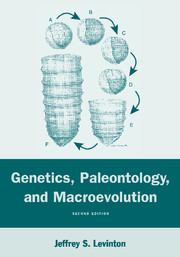Book contents
- Frontmatter
- Contents
- Preface to the First Edition
- Preface to the Second Edition
- 1 Macroevolution: The Problem and the Field
- 2 Genealogy, Systematics, and Macroevolution
- 3 Genetics, Speciation, and Transspecific Evolution
- 4 Development and Evolution
- 5 The Constructional and Functional Aspects of Form
- 6 Patterns of Morphological Change in Fossil Lineages
- 7 Patterns of Diversity, Origination, and Extinction
- 8 A Cambrian Explosion?
- 9 Coda: Ten Theses
- Glossary of Macroevolution
- References
- Author Index
- Subject Index
Preface to the First Edition
Published online by Cambridge University Press: 14 January 2010
- Frontmatter
- Contents
- Preface to the First Edition
- Preface to the Second Edition
- 1 Macroevolution: The Problem and the Field
- 2 Genealogy, Systematics, and Macroevolution
- 3 Genetics, Speciation, and Transspecific Evolution
- 4 Development and Evolution
- 5 The Constructional and Functional Aspects of Form
- 6 Patterns of Morphological Change in Fossil Lineages
- 7 Patterns of Diversity, Origination, and Extinction
- 8 A Cambrian Explosion?
- 9 Coda: Ten Theses
- Glossary of Macroevolution
- References
- Author Index
- Subject Index
Summary
I have so many things to write about, that my head is as full of oddly assorted ideas, as a bottle on the table is filled with animals.
– Charles Darwin, 1832, Rio de JaneiroEvolutionary biology enjoys the peculiar dual status of being that subject which clearly unites all biological endeavors, while occasionally seeming to be nearly as remote from complete understanding as when Darwin brought it within the realm of materialistic science. Somehow, the basic precepts first proposed by Darwin have never been either fully accepted or disposed, to be followed by a movement toward further progress in some other direction. The arguments of today – the questions of natural selection and adaptation, saltation versus gradualism, and questions of relatedness among organisms – are not all that different from those discussed 100 years ago, even if the research materials seem that much more sophisticated.
Darwin espoused thinking in terms of populations. His approach was open to experimentation, but this had to await the (re)discovery of genetics half a century later, before a major impediment to our understanding could be thrown aside. As it turned out, the rediscovery of genetics was initially more confusing than helpful to our understanding of evolution. The rediscovery of genetically transmissible discrete traits revived saltationism, and it took over a decade for biologists to realize that there was no conflict between the origin of discrete variants and the theory of natural selection. In the twentieth century, the focus of experimentalists moved toward processes occurring within populations. But many of the inherently most fascinating questions lie at higher taxonomic levels, or at greater distances of relationship than between individuals in a population.
Information
- Type
- Chapter
- Information
- Genetics, Paleontology, and Macroevolution , pp. ix - xiiPublisher: Cambridge University PressPrint publication year: 2001
